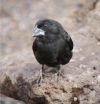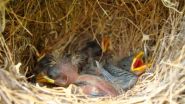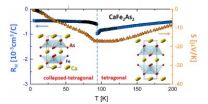(Press-News.org) Researchers have found a way to protect threatened Darwin's finches on the Galápagos Islands from deadly parasitic nest flies in a manner that's as simple as it is ingenious: by offering the birds insecticide-treated cotton for incorporation into their nests. The study, reported in the Cell Press journal Current Biology on May 5, shows that the birds will readily weave the protective fibers in. What's more, the researchers find that just one gram of treated cotton is enough to keep a nest essentially parasite-free.
The findings come as welcome news for the future of Darwin's finches, including the mangrove finch, one of the world's most endangered birds, the researchers say. Fewer than 100 mangrove finches survive on the Galápagos today.
"These flies were recently introduced to the Galápagos, where they parasitize nearly all nesting land bird species on the islands," says Sarah Knutie of the University of Utah. "In some years, 100% of Darwin's finch nestlings die as a direct result of the parasite."
It is the fly larvae that cause the trouble. Adult flies lay their eggs in the birds' nests. When the insect larvae hatch, they feed on the blood of the nestlings and their mother. Their devastating toll on the survival of young finches has made fighting the flies a top priority for bird conservation in the Galápagos.
Knutie says she and her colleagues have used permethrin, a common insecticide, for many years to combat parasites in the nests. But they had a new idea after several finch species were seen pulling cotton fibers from laundry lines and weaving the cotton into their nests. Would the birds be willing to use permethrin-treated cotton, too?
To find out, the researchers set up 30 dispensers, some with permethrin-treated cotton and some with water-treated cotton, at intervals in their Galápagos field site. After the breeding season was over, they collected nests and found that most of them (85%) included cotton. Many of the nests, which were built by multiple finch species, contained the permethrin-treated cotton. Of those with at least one gram of treated cotton, all but one were completely parasite-free. (The one parasitized nest with at least one gram of permethrin-treated cotton had four parasites, compared with an average of 30 in control nests.)
In a separate experiment, Knutie and colleagues showed that nests sprayed with permethrin produce many more surviving nestlings. Nineteen of twenty treated nests fledged at least one offspring, while only 11 of 17 control nests fledged any offspring.
"Novel parasites and diseases are an increasing threat to our environment," Knutie says. "Many animals cannot defend themselves against such parasites. Therefore, the animals need our help in developing effective ways to protect them. Our method of self-fumigation is a simple and immediate solution that can help Darwin's finches combat this devastating parasite."
The Charles Darwin Research Station is currently in the process of testing this method for mangrove finches on Isabela Island, the largest of the Galápagos, and Knutie says she continues to advise on use of the self-fumigation method in the Galápagos.
INFORMATION:
Current Biology, Knutie et al.: "Darwin's finches combat introduced nest parasites with fumigated cotton."
With 'self-fumigation,' Darwin's finches combat deadly parasitic flies
2014-05-05
ELSE PRESS RELEASES FROM THIS DATE:
Tracking turtles through time, Dartmouth-led study may resolve evolutionary debate
2014-05-05
Turtles are more closely related to birds and crocodilians than to lizards and snakes, according to a study from Dartmouth, Yale and other institutions that examines one of the most contentious questions in evolutionary biology.
The findings appear in the journal Evolution & Development. A PDF of the study is available on request.
The research team looked at how the major groups of living reptiles, which number more than 20,000 species, are interrelated. The relationships of some reptile groups are well understood -- birds are most closely related to crocodilians among ...
Climate change threatens to worsen US ozone pollution
2014-05-05
BOULDER -- Ozone pollution across the continental United States will become far more difficult to keep in check as temperatures rise, according to new research led by the National Center for Atmospheric Research (NCAR). The detailed study shows that Americans face the risk of a 70 percent increase in unhealthy summertime ozone levels by 2050.
This is because warmer temperatures and other changes in the atmosphere related to a changing climate, including higher atmospheric levels of methane, spur chemical reactions that lead to ozone.
Unless emissions of specific pollutants ...
Genetic, environmental influences equally important risk for autism spectrum disorder
2014-05-05
In the largest family study on autism spectrum disorder (ASD) to date, researchers from the Icahn School of Medicine at Mount Sinai, along with a research team from the Karolinska Institutet in Stockholm Sweden and King's College in London found that individual risk of ASD and autistic disorder increased with greater genetic relatedness in families – that is, persons with a sibling, half-sibling or cousin diagnosed with autism have an increased likelihood of developing ASD themselves. Furthermore, the research findings showed that "environmental" factors unique to the ...
Energy-subsidy reform can be achieved with proper preparation, outside pressure
2014-05-05
HOUSTON – (May 5, 2014) – Reform of energy subsidies in oil-exporting countries can reduce carbon emissions and add years to oil exports, according to a new paper from Rice University's Baker Institute for Public Policy.
"Navigating the Perils of Energy-Subsidy Reform in Exporting Countries" was authored by Jim Krane, the Wallace S. Wilson Fellow for Energy Studies at the Baker Institute, who specializes in energy geopolitics. The paper reviews the record of energy-subsidy reforms and argues that big exporters should reduce energy demand by raising prices, and that this ...
Liver cancer screening highly beneficial for people with cirrhosis
2014-05-05
DALLAS – May 5, 2014 – Liver cancer survival rates could be improved if more people with cirrhosis are screened for tumors using inexpensive ultrasound scans and blood tests, according to a review by doctors at UT Southwestern Medical Center.
The meta-analysis of 47 studies involving more than 15,000 patients found that the three-year survival rate was much higher among patients who received liver cancer screening— 51 percent for patients who were screened compared to 28 percent of unscreened patients. The review also found that cirrhosis patients who were screened for ...
Study finds family-based exposure therapy effective treatment for young children with OCD
2014-05-05
PROVIDENCE, R.I. – A new study from the Bradley Hasbro Children's Research Center has found that family-based cognitive behavioral therapy (CBT) is beneficial to young children between the ages of five and eight with Obsessive-Compulsive Disorder (OCD). The study, now published online in JAMA Psychiatry, found developmentally sensitive family-based CBT that included exposure/response prevention (EX/RP) was more effective in reducing OCD symptoms and functional impairment in this age group than a similarly structured relaxation program.
Jennifer Freeman, Ph.D., a staff ...
Tomato turf wars: Benign bug bests salmonella; tomato eaters win
2014-05-05
Scientists from the U.S. Food and Drug Administration (FDA) have identified a benign bacterium that shows promise in blocking Salmonella from colonizing raw tomatoes. Their research is published ahead of print in the journal Applied and Environmental Microbiology.
When applied to Salmonella-contaminated tomato plants in a field study, the bacterium, known as Paenibacillus alvei, significantly reduced the concentration of the pathogen compared to controls.
Outbreaks of Salmonella traced to raw tomatoes have sickened nearly 2,000 people in the US from 2000-2010, killing ...
Physician practice facilitation ensures key medical care reaches children
2014-05-05
Leona Cuttler, MD, knew in her core that the simple act of adding an outside eye could dramatically improve pediatric care.
Today, a study of more than 16,000 patient visits published online in the journal Pediatrics proves Cuttler's thesis correct. The lead investigator on the research project, Cuttler succumbed to cancer late last year. But her colleagues are committed to seeing its lessons disseminated across the country.
"It was an honor to work on this project with Dr. Cuttler," said study first author Sharon B. Meropol, MD, PhD, Assistant Professor, Departments ...
ORNL paper examines clues for superconductivity in an iron-based material
2014-05-05
OAK RIDGE, Tenn., May 5, 2014 – For the first time, scientists have a clearer understanding of how to control the appearance of a superconducting phase in a material, adding crucial fundamental knowledge and perhaps setting the stage for advances in the field of superconductivity.
The paper, published in Physical Review Letters, focuses on a calcium-iron-arsenide single crystal, which has structural, thermodynamic and transport properties that can be varied through carefully controlled synthesis, similar to the application of pressure. To make this discovery, researchers ...
New cause of high blood pressure and heart disease discovered
2014-05-05
Phosphate rich foods include processed cheese, Parmesan, cola, baking powder and most processed foods. Phosphates are widely used in the food industry as preservatives and pH stabilizers. When large quantities of phosphates are consumed, production of the FGF23 hormone is stimulated, which has a negative effect on the cardiovascular system. Reinhold Erben, the head of the Unit of Physiology, Pathophysiology and Biophysics at the Vetmeduni Vienna, warns that "our phosphate consumption is relevant for our state of health."
Over 500 million people around the world suffer ...




